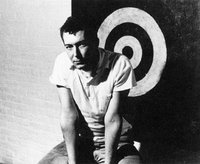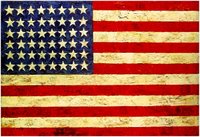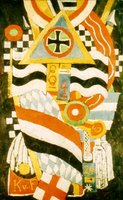Jasper Johns
 Jasper Johns born 15 May 1930
Jasper Johns born 15 May 1930Jasper Johns is a contemporary American artist best known for painting and printmaking and associated with the Pop Art and Neo-Dada movements.
Born in Augusta, Georgia, Jasper Johns grew up in Allendale, South Carolina. Johns studied at the University of South Carolina from 1947 to 1948. He then moved to New York City and studied briefly at Parsons School of Design in 1949. While in New York, Johns met Robert Rauschenberg, with whom he had a artistic and sexual relationship, as well as Merce Cunningham and John Cage. Working together they explored the contemporary art scene, and began developing their ideas on art. United by friendship and shared homosexuality they were to have a profound effect on the creative arts in 1950s New York - helping to define post-modernism.
In 1952 and 1953 he was stationed in Sendai, Japan during the Korean War.
In 1958, gallery owner Leo Castelli discovered Johns while visiting Robert Rauschenberg's studio.
 Johns is best known for his painting Flag (1954-55), which he painted after having a dream of the American flag. His work is often described as a 'Neo-Dadaist', as opposed to pop art, even though his subject matter often includes images and objects from popular culture. Still, many compilations on pop art include Jasper Johns as a pop artist because of his artistic use of classical iconography.
Johns is best known for his painting Flag (1954-55), which he painted after having a dream of the American flag. His work is often described as a 'Neo-Dadaist', as opposed to pop art, even though his subject matter often includes images and objects from popular culture. Still, many compilations on pop art include Jasper Johns as a pop artist because of his artistic use of classical iconography.Early works were composed using simple schema such as flags, maps, targets, letters and numbers. Johns' treatment of the surface is often lush and painterly; he is famous for incorporating such media as Encaustic (wax-based paint), and plaster relief in his paintings. Johns played with and presented opposites, contradictions, paradoxes, and ironies, much like Marcel Duchamp (who was associated with the Dada movement). Johns also produces intaglio prints, sculptures and lithographs with similar motifs.
 Johns' breakthrough move, which was to inform much later work by others, was to appropriate popular iconography for painting, thus allowing a set of familiar associations to answer the need for subject. Though the Abstract Expressionists disdained subject matter, in the end it could be said that they simply changed subjects. Johns neutralised the subject, so that something like pure paint - painted surface - could declare itself. For twenty years after Johns painted Flag, the surface - in Andy Warhol's silkscreens or Robert Irwin's illuminated ambiances - could suffice.
Johns' breakthrough move, which was to inform much later work by others, was to appropriate popular iconography for painting, thus allowing a set of familiar associations to answer the need for subject. Though the Abstract Expressionists disdained subject matter, in the end it could be said that they simply changed subjects. Johns neutralised the subject, so that something like pure paint - painted surface - could declare itself. For twenty years after Johns painted Flag, the surface - in Andy Warhol's silkscreens or Robert Irwin's illuminated ambiances - could suffice. In contrast to the concept of macho 'artist hero' as ascribed to Abstract Expressionist figures such as Jackson Pollock and Willem de Kooning, whose paintings are fully indexical (that is, standing effectively as an all-over canvas signature), Neo-Dadaists like Johns and Robert Rauschenberg seem preoccupied with a lessening of the reliance of their art on indexical qualities, seeking instead to create meaning solely through the use of conventional symbols, painted indexically in what some have interpreted as a rebuttal of the hallowed individuality of the Abstract Expressionists. There is also the issue of symbols existing outside of any referential context; Johns' flag, for instance, is primarily a visual object, divorced from its symbolic connotations and reduced to something in-itself.
In contrast to the concept of macho 'artist hero' as ascribed to Abstract Expressionist figures such as Jackson Pollock and Willem de Kooning, whose paintings are fully indexical (that is, standing effectively as an all-over canvas signature), Neo-Dadaists like Johns and Robert Rauschenberg seem preoccupied with a lessening of the reliance of their art on indexical qualities, seeking instead to create meaning solely through the use of conventional symbols, painted indexically in what some have interpreted as a rebuttal of the hallowed individuality of the Abstract Expressionists. There is also the issue of symbols existing outside of any referential context; Johns' flag, for instance, is primarily a visual object, divorced from its symbolic connotations and reduced to something in-itself.Since the 1980s, Johns produces paintings at four to five a year, sometimes not at all during a year. His large scale paintings are much favoured by collectors and due to their rarity, it is known that Johns' works are extremely difficult to acquire.
Above, Jasper Johns, 1997 by Chuck Close
Labels: Artists, Painters, Photographers, Pop Art




































 George Tooker born 5 August 1920
George Tooker born 5 August 1920













